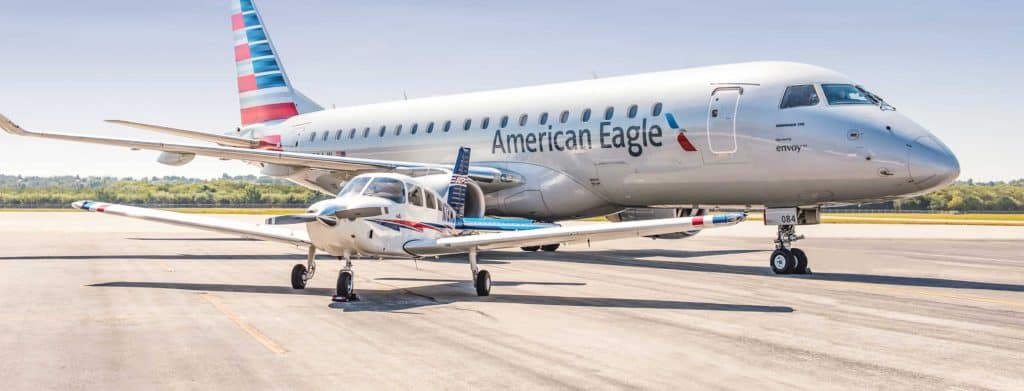Jump to...
Commercial Flight Schools Demystified: Your Pathway to Professional Aviation
Table of Contents

Learning to fly is a dream many people share, yet not everyone knows where to start. Commercial flight schools are institutions designed to take a person from zero flight experience to a fully licensed professional pilot. This article will guide you through the overview of commercial flight schools, the benefits they offer, as well as the challenges you may face.
Insight into Commercial Flight Schools: Your Key to a Professional Pilot Career
- Commercial Flight Schools offer a structured environment to gain your pilot’s license. They provide a comprehensive curriculum that covers everything from basic flight principles to advanced navigation techniques. The programs are usually full-time, and you can expect to fly several times a week, if not daily.
Advantages of Commercial Flight Schools: A Launchpad to Your Flying Dream
- One of the major benefits of attending a commercial flight school is the professional instructors who have extensive experience in the aviation industry. They can provide invaluable insights that you might not get otherwise. Additionally, commercial flight schools often have connections within the industry, which can help you land your first job as a pilot.
Overcoming the Challenges of Commercial Flight Schools: Turning Hurdles into Stepping Stones
- While there are many benefits to attending a commercial flight school, there are also challenges to consider. One of the primary challenges is the cost; flight training is expensive and can be a significant financial commitment. Also, the intense nature of the curriculum can be demanding, requiring a significant time commitment and discipline to stay on top of coursework.
Making the Right Choice: Your Comprehensive Guide to Selecting a Commercial Flight School
- Choosing to attend a commercial flight school is a big decision, but it can be a rewarding one. By understanding what these schools offer and the challenges they present, you can make an informed decision about your path to becoming a professional pilot.
Remember, every pilot’s journey is unique. Your choice should align with your personal circumstances, career goals, and passion for flying. Whether you decide to attend a commercial flight school or choose another route to professional aviation, the sky’s the limit!
Commercial Flight School Admissions Unveiled: Your Step-by-Step Guide to Commercial Flight Training
Commercial flight schools usually have an open admissions policy. This means that anyone who meets the Federal Aviation Administration’s (FAA) requirements for a student pilot certificate can apply. The requirements include being at least 16 years old (or 17 for the private pilot certificate), fluent in English, and in good physical health.

- Application Process for Commercial Flight Schools The application process generally involves filling out an application form, providing proof of meeting FAA requirements, and often, an interview with the flight school. Some schools may also require a flight physical examination to ensure you meet the FAA medical standards.
- Success Rate of Commercial Flight School Graduates According to the FAA, in 2020, around 90% of individuals who started flight training at a commercial flight school obtained at least a private pilot certificate. Furthermore, many pilots who start their careers in commercial flight schools eventually transition to professional pilot roles.
- Navigating the Challenges One of the main challenges in the application process is funding your training. Commercial flight school can be expensive, and securing the necessary funds can be a hurdle. Some schools offer financing options or scholarships, so it’s worth investigating these opportunities.
Essential Resources for Commercial Flight School Admissions: Your Toolkit for Success
Top 5 Commercial Flight Schools in the US That Are Not Universities or Colleges
Here is a ranking of the top 5 commercial flight schools in the United States that are not universities or colleges. The ranking is based on a number of factors, including the school’s reputation, its facilities, its curriculum, and its cost.
ATP Flight School is the largest flight school in the United States. It has a network of over 70 locations across the country. The school offers a variety of flight training programs, including private pilot, instrument rating, commercial pilot, and airline transport pilot. ATP Flight School is known for its high-quality training and its commitment to safety.
Price: $80,000 – $100,000
Pros:
- Large network of locations
- High-quality training
- Commitment to safety
Cons:
- Expensive
- Long training time
FlightSafety International is a leading provider of aviation training. It has a network of over 80 locations in the United States and around the world. The school offers a variety of flight training programs, including private pilot, instrument rating, commercial pilot, and airline transport pilot. FlightSafety International is known for its use of state-of-the-art simulators and its experienced instructors.
Price: $100,000 – $120,000
Pros:
- Large network of locations
- State-of-the-art simulators
- Experienced instructors
Cons:
- Expensive
- Long training time
Universal Aviation is a leading provider of aviation services. It has a network of over 100 locations in the United States and around the world. The company offers a variety of flight training programs, including private pilot, instrument rating, commercial pilot, and airline transport pilot. Universal Aviation is known for its flexible training options and its commitment to customer service.
Price: $80,000 – $100,000
Pros:
- Large network of locations
- Flexible training options
- Commitment to customer service
Cons:
- Not as well-known as some other schools
- Not as many training options as some other schools
American Flyers is a leading provider of flight training. It has a network of over 10 locations in the United States. The school offers a variety of flight training programs, including private pilot, instrument rating, commercial pilot, and airline transport pilot. American Flyers is known for its use of state-of-the-art aircraft and its experienced instructors.
Price: $80,000 – $100,000
Pros:
- Use of state-of-the-art aircraft
- Experienced instructors
Cons:
- Not as many locations as some other schools
- Not as many training options as some other schools
5. CAE Oxford Aviation Academy
CAE Oxford Aviation Academy is a leading provider of flight training. It has a network of over 10 locations in the United States and around the world. The school offers a variety of flight training programs, including private pilot, instrument rating, commercial pilot, and airline transport pilot. CAE Oxford Aviation Academy is known for its use of state-of-the-art simulators and its experienced instructors.
Price: $100,000 – $120,000
Pros:
- Use of state-of-the-art simulators
- Experienced instructors
Cons:
- Expensive
- Long training time
When choosing a flight school, it is important to consider a number of factors, including the school’s reputation, its facilities, its curriculum, and its cost. It is also important to choose a school that is a good fit for your individual needs and goals.
Additional Resources: Your Pathway to Flight
Here are some resources where you can find additional flight schools:
Remember, always do thorough research and choose a flight school that best fits your career goals and personal circumstances. Safe flying!
Eligibility Criteria: Understanding Your GI Bill Benefits for Flight Training

As veterans transition back to civilian life, they often look for ways to utilize their military benefits, like the GI Bill, to further their education and career prospects. One area where these benefits can be beneficial is in flight training. However, navigating the process can be complex. Here’s a detailed discussion on how to apply and use the GI Bill for Flight Training.
How to Apply for GI Bill Benefits for Flight Training: A Step-by-Step Guide
Determine Your Eligibility: The first step is to determine if you are eligible for benefits under the GI Bill. There are several versions of the GI Bill, including the Montgomery GI Bill and the Post-9/11 GI Bill, each with its own set of eligibility requirements. Visit the VA website for detailed eligibility criteria.
Choose the Right Flight School: Not all flight schools are eligible to receive GI Bill benefits. Ensure the flight school you choose is approved by the VA.
Apply for Benefits: Once you have determined your eligibility and chosen a flight school, the next step is to apply for benefits. You can apply online through the VA website.
Wait for Certificate of Eligibility: After applying, you will receive a Certificate of Eligibility (COE) in the mail. This document proves that you are eligible for GI Bill benefits.
Submit Certificate of Eligibility to Your Flight School: Once you receive your COE, submit it to your flight school. They will then work with the VA to arrange for your benefits to be paid.
Exploring Flight Ratings and Certifications: Maximizing Your GI Bill Benefits
There are several flight ratings and certifications you can obtain using your GI Bill benefits. These include private pilot license, commercial pilot license, instrument rating, and certified flight instructor (CFI) among others.
Top Resources for Navigating Your GI Bill Flight Training
GI Bill Comparison Tool: The VA provides a comparison tool that allows you to compare approved flight schools and see how much of your tuition will be covered by your benefits.
VA Education Benefits: The VA’s Education and Training page provides information on the different types of GI Bills, how to apply for benefits, and how to manage your benefits once you have them.
FAA Flight Schools Directory: The FAA provides a directory of flight schools which can be filtered to show only those that are VA approved.
Veteran Pilot Associations: Organizations such as the Veterans Airlift Command and Veteran’s Pilot Association provide support and resources for veteran pilots.
Using your GI Bill benefits for flight training can be a great way to start a new career in aviation. With careful planning and the right resources, you can maximize your benefits and reach your professional goals.


